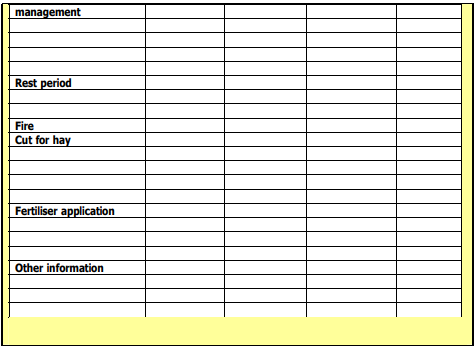Evaluation of the Deterioration And The Route Of Deterioration
What is meant by deterioration?
Deterioration is a process of allowing natural recourses to break down to a stage where their production value is lost forever. It is a negative process caused by various factors, thus the main reason why natural resource management needs to be put in place.
Rehabilitation Measures
To overcome the effect of deterioration on e.g. natural vegetation, the implementing of rehabilitation measures need to be put in place to try and re-establish the natural vegetation to its natural form.
Rehabilitation measures may include the following:
- Rotate grazing allowing camps to rest.
- Establish new pastures – cultivate the damaged area to allow water absorption and encouragement of new growth - seed or seedlings.
- The construction of contour banks and waterways to prevent runoff of water.
- The improvement and maintenance of poorly maintained water structures.
- Build or construct barriers in damaged areas to prevent further damage and to slow down the runoff and flow of water.
- Croplands can be rehabilitated by installing a draining system; adding agricultural lime to the soil to reduce the acidity and to prevent aluminium toxicity
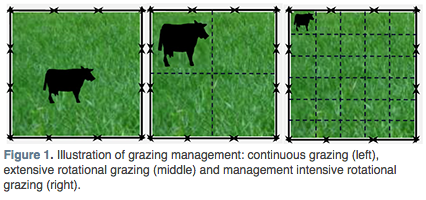
The proper way to manage natural resources would be not to allow any damages but to ensure that the status of natural resources is kept at a level where rehabilitation is not necessary.
Important reasons for not allowing deterioration of natural resources:
- Rehabilitation costs - it will need additional inputs and cultivation.
- The loss of soil productivity – loss of income.
- Constructing costs - structures in damaged or eroded areas.
- Constructing and maintenance costs of new contour banks and waterways.
- Silt deposit of runoff water in dams - reduce the water holding capacity
Deterioration of veld or soil can be caused by the following:
- Overgrazing.
- Not allowing a camp to recover - no seedlings.
- Un-controlled burning of the veld.
- Erosion.
- Bush encroachment.
The deterioration of cultivated lands can be caused by the following:
- Mono cultivating – planting the same crop year after year.
- Over application of fertilisers.
- Over irrigation of soil.
- The build-up of toxins in the soil.
- The lack of regular soil testing to determine the soil’s nutritional status.
- The production system where fallow land is used (without fertilisers) until it is no longer fertile - then move to the next area, applying the same method – slash and burn system.
Topography, Climate, Vegetation and Soil
The topography will influence the vegetation of that specific area because of the following reasons:
Temperature
- The heat units vary on the different slopes.
- The altitude above sea level; the higher-the-colder and exposed to changing weather.
- The daily temperature in valleys is cooler than on the slopes or the plateau.
- The quantity of sunlight differs on the different sides - the shady side of the area will be cooler than the northern side which is exposed to direct sunlight the whole day.
- Vegetation will vary due to the quantity of shade or temperature - trees do not grow at high altitudes but natural forests occur at definite temperature zones.
- Northern slopes will be drier than southern slopes due to different sunlight hours and temperatures.
Sunlight
- The quality of sunlight varies with altitude – the intensity of ultraviolet radiation increases at higher altitudes.
- The incoming radiation increases northwards during winter.
- Shade tolerating plants grow on the southern slopes and sunlight tolerating vegetation on the northern slopes.
- Sunlight penetration is poor in areas with very dense flora (e.g. a forest) - with little or non-undergrowth.
- More shade tolerating flora present in valleys than on the plateau.
Moisture
Xerophytes plants can withstand and survive in extremely dry conditions.
Mesophytes plants prefer wet areas.
Bulbous plants store moisture in their bulbs to survive during a drought.
The topography of the land can also influence the moisture in the following ways:
- The tempo of runoff water is higher on sloped areas – absorption of water low - than on the flat areas.
- The water absorption will depend on the type of rain, soil and the angle of the slope.
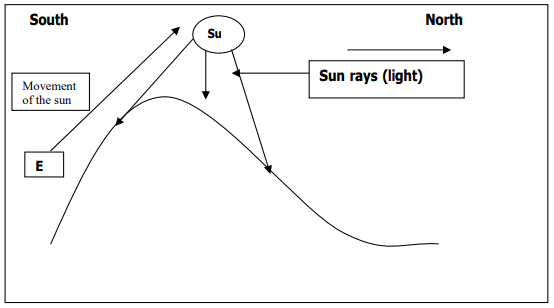
Soil
Soil is formed by erosion and weathering of rocks, thus a medium for natural vegetation to grow in. This newly formed soil is unfertile at first, but with the support of plants, the formation and fertility is changed, allowing the survival of different kinds of flora. The plants take up nutrients from the soil but replace it again in the form of compost (leaves or dead plants parts). The excrement of the animals, after eating these plants, also adds nutrients to the soil for plants to grow on.
Different plants prefer different soil types. It is thus important that plants are planted in an area where they are adapted to.
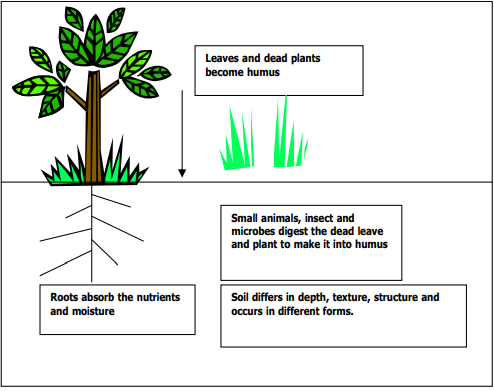
The hummus and the mineral clay fraction play an important role in controlling many of the properties in the soil:
- Absorbing large quantities of water.
- Adsorbing mineral nutrients and reducing losses that may result from leaching.
- Acting as a cementing agent. Individual soil particles are cemented into aggregates by the small humus and clay particles.
Availability of Natural Resources
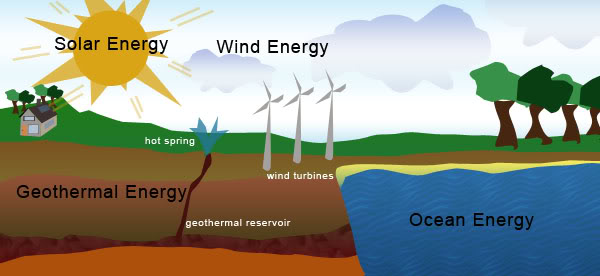
To determine the availability of natural resources the following can be done:
Water: Determine the volume of water a borehole can deliver by using a test pump for at least 8 hours. That will determine the capacity of the water supply. Determine the depth of the borehole as well as the distance to the reservoir to calculate the choice of pump as well as total costs of water supply. All the other water sources – dams in catchments, etc. need to be calculated to determine whether there will be sufficient water supply for e.g., irrigation or animal use.
The soil: The quality, type and nutrient content in the soil can only be determined by soil analyses. (The method of soil sampling is discussed in unit 116309). The outcome of these analyses is very important as it will aid the farmer during the decision-making process to determine the use of the soil - crop production, production of fodder or animal grazing.
Natural vegetation: Determine the veld condition and occurrence and quality of natural vegetation - based on the extent of dominant species and the overall covering – whilst the veld is in an optimum growing condition. The idée is to select standard sites which will be used as benchmarks when rating the veld in the same ecological zone.
Selecting a benchmark site, choose a site that is:
- Productive and stable,
- Represents the type of veld that is suspected to be the natural veld,
- Representing the climax state of the veld.
The site is analysed in the following manner:
- Select an area of 30 m x 30m - approximately 0.1 ha
- Record within this area - at 200 randomly allocated positions - the species’ occurrence and basal covering by means of a wheel point apparatus. (You can also make use of your shoe – e.g., mark your left shoe with chalk and every time your left shoe touches down, identify the species next to the mark.
- Record the strikes as follow:

% basal cover = a number of strikes from the 200 points / 2 % contribution of each species = number of recorded positions for each species from 200 positions /2 The species in the benchmark site must then be classified into four classes.
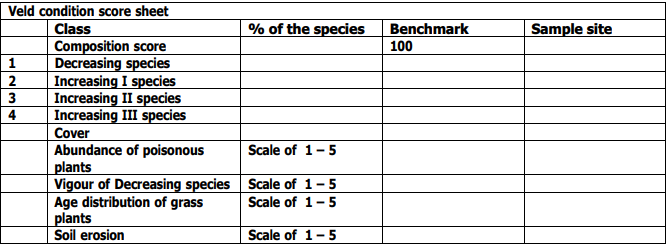
Where the veld survey indicates deterioration of the natural vegetation due to overgrazing or other factors, the following need to be done to prevent further degradation:
- Reduce the stocking rate
- Provide appropriate resting period
In the savannah area, it is also necessary to analyse the three components of the vegetation and not only the grasses and other plants. The trees must be recorded separately.
Condition indications of trees:

Coppice plants: – a small clump of trees with undergrowth - new wood growing from the bottom of plants.
Click here to view a video that explains the use of coppiced trees.
A management program can be compiled with this information (the tree population and grass analysis) regarding the camp rotation, type of animals (sheep, cattle or game) that can be used and the stocking rate.
Land Use Plan
A land-use plan is a detailed compilation of what happened on a specific land or veld in the past (yield, input costs, fertilisers, etc.), thus the complete history of every land or camp. A farm management plan can barely be compiled without this recorded information.
This is an example of a land-use plan for a natural pasture.

